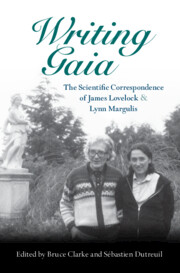Book contents
- Writing Gaia: The Scientific Correspondence of James Lovelock and Lynn Margulis
- Reviews
- Writing Gaia: The Scientific Correspondence of James Lovelock and Lynn Margulis
- Copyright page
- Epigraph
- Table of Contents
- Figures
- Contributors
- Foreword by James Lovelock
- Preface
- Acknowledgements
- Introduction
- Part I 1970–1972
- Part II 1973–1979
- Part III 1980–1991
- Part IV 1992–2007
- Part V Commentaries on Lovelock and Margulis
- Darwinizing Gaia
- Gaia at the Margulis Lab
- Gaia and the Water of Life
- Gaia as a Problem of Social Theory
- Befriending Gaia: My Early Correspondence with Jim Lovelock
- Gaia’s Pervasive Influence
- Gaia’s Microbiome
- Tangled Up in Gaia
- Lovelock and Margulis
- Discovering Geology, Discovering Gaia
- Glossary of Names
- Glossary of Terms
- Bibliography
- Index
Gaia’s Pervasive Influence
from Part V - Commentaries on Lovelock and Margulis
Published online by Cambridge University Press: 28 July 2022
- Writing Gaia: The Scientific Correspondence of James Lovelock and Lynn Margulis
- Reviews
- Writing Gaia: The Scientific Correspondence of James Lovelock and Lynn Margulis
- Copyright page
- Epigraph
- Table of Contents
- Figures
- Contributors
- Foreword by James Lovelock
- Preface
- Acknowledgements
- Introduction
- Part I 1970–1972
- Part II 1973–1979
- Part III 1980–1991
- Part IV 1992–2007
- Part V Commentaries on Lovelock and Margulis
- Darwinizing Gaia
- Gaia at the Margulis Lab
- Gaia and the Water of Life
- Gaia as a Problem of Social Theory
- Befriending Gaia: My Early Correspondence with Jim Lovelock
- Gaia’s Pervasive Influence
- Gaia’s Microbiome
- Tangled Up in Gaia
- Lovelock and Margulis
- Discovering Geology, Discovering Gaia
- Glossary of Names
- Glossary of Terms
- Bibliography
- Index
Summary
“Chris, I think you will enjoy this.” It was December 1986, and those were the prophetic words of a colleague as he passed me the latest copy of New Scientist magazine. We academics read countless articles, most of which are of fleeting interest. But every so often a piece hits the “Aha” button and changes the way one thinks. So it was with the article; “Gaia: the world as living organism” (Lovelock 1986a). It was my first encounter with the mind of Jim Lovelock. At the time I was leading a rapidly growing research group dedicated to the study of the Earth from space. Using instruments on polar orbiting spacecraft, we were opening up new windows on the planet, revealing how the ice, oceans, atmosphere, and land interact. It was a thrilling time – an Aladdin’s cave of new opportunities to piece together a picture of the Earth system as an integrated whole. But as a physical scientist, with limited knowledge of biology, my focus on the biosphere was minimal. Jim’s paper argued that living organisms play an active – even dominant – role in keeping the planet fit for life. He presented his Daisyworld model to demonstrate that homeostasis through biological cybernetic feedbacks can be an emergent property. The study of the Earth system could as much ignore the role of life as it could deny the influence of atmospheric chemistry or the Sun. I was shaken. I prided myself on spotting and developing fertile connections across academic silos. It was disturbing to realize that my “biological blind spot” was a significant gap. I very much wanted to meet Jim, to explore his ideas further, but could think of only flimsy excuses. The task of developing and exploiting the early series of European polar orbiting satellites kept us busy, and so the prospect slipped to the back of my mind.
- Type
- Chapter
- Information
- Publisher: Cambridge University PressPrint publication year: 2022



